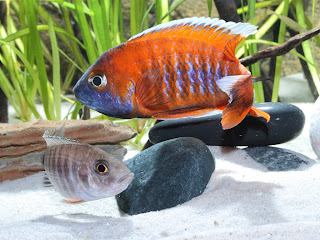12 Eylül 2012 Çarşamba
AULONOCARA JACOBFREIBERGI “EUREKA”
Kind
Aulonocara jacobfreibergi, Feenbuntbarsch, breeding form "Eureka"
Breeding Ground
Colourful, lively
Breeding Animals
One male and several females
Breeding Structure
300 liters, rocks, strong filtering, weekly water changes
Water Levels
Temperature, GH 10>, KH 5> pH7, 5 - 8, etc.
24 to 28 degrees,
Feed
Flake food, some frozen food (no red mosquito larvae)
Livestock Feed
Artemia for young fish
Feenbuntbarsch is the German name for the Aulonocara jacobfreibergi, from the East African Lake Malawi. Some aquarists will know him nor under the generic name Trematocranus.
Under the trade name "eureka" in a breeding aquarium is widespread, when the red is highlighted. Even the albino form is a powerful red, the sky-blue dorsal fin makes this a nice contrast.
In A. jacobfreibergi is, as with most Malawiseebuntbarschen, a mouth brooder. Lake Malawi and the aquarium are the males their territories in caves or under rocks that are unexcavated. Conspecifics and not sexually mature females are chased away. To avoid injury, the aquarium should be set up with many hiding places.
During courtship, the female will spawn willing swum fast. The male lies down diagonally in front of her on the side and begins to tremble with the anal fin. Fawned with movements he lures them into his territory. Both animals spinning around and the female swims toward the shaking offered her anal fin. During courtship, the female aggression on the remaining pelvic residents are degraded. Other animals are threatened with raised fins and chased away. After several pairings, it is apparent to lay their eggs. The female lays from some eggs and immediately takes them into his mouth. Then she swims back to the anal fin of the male, which now gives his sperm and fertilizes the eggs. The process is repeated until the entire spawning was issued.
The breeding season of the female is 21 days. During this time no food being consumed. 50 pups expected - per litter, depending on the size of the females 20. The approximately eight millimeters pups eat immediately Artemia and fine fodder. After six months, the first Aulonocara jacobfreibergi have reached sexual maturity. With 12 to 15 cm, the males are fully grown. Females are only about 10 inches tall.
Etiketler:
“EUREKA”,
aquarium fish,
AULONOCARA JACOBFREIBERGI,
freshwater fish
BADIS SINGENENSIS – “BUXAR”
Origin
As the area of origin of these animals is given to the Buxa National Park in the state of West Bengal in India.
Description
The animals reach a maximum length of 5 cm, while keeping the females slightly smaller. When keeping temperature are the animals, the number of animals from India, not all that warmth and content with temperatures between 15 ° C and 25 ° C.
The animals are suitable for aquariums from 60 cm and can be socialized very well with small peaceful species. However, it should be selected species that are present in the upper and middle layers of the water, as the Badis talk usually close to the ground, where they are constantly in search of food on.
When keeping the water levels are rather subordinate, while this one is a “normal” zone.
Breeding
The animals were already propagated and spawn in small caves, where the male takes over the care and defense of the eggs and larvae. The hatch - depending on the temperature - after 2 to 3 days and leave the cave until after 6 to 8 days. Then you should be transferred to the other in a separate breeding aquarium, where they can be fed with newly hatched Artemia and microworms. When a culture would be consistent with rotifers available, it would be necessary for the first few days of an advantage but not essential.
Etiketler:
aquarium fish,
BADIS SINGENENSIS,
buxar,
freshwater fish
TROPHEUS DUBOISI
Origin
Africa; shore shoreline in Lake Tanganyika, in the northwest and in the central east coast
Habitat
Sedimentary rocks Free Zone in 3 to 15 m depth
Description
This up to 12 cm long cichlids have no external sex differences, the males are larger and have longer pelvic fins than females. The latter show as an adult on the back often have white spots. In Rock Artaquarium without plants, but with many through caves, these cichlids are well housed. They are kept in pairs or in groups over medium grade sand, then proceed with the mouthbrooders mother family and procreation. Interesting is the age-related change of color: Only the juveniles have white spots on a dark background, which later disappear. Then a vertical yellow or white body is formed as a band drawing. Is closely related to T. moorii, the Brabant cichlid, see separate species profile.
The species is an extreme Limniphor (growth eaters)
Etiketler:
aquarium fish,
duboisi,
freshwater fish,
tropheus,
TROPHEUS DUBOISI
Kaydol:
Yorumlar (Atom)





